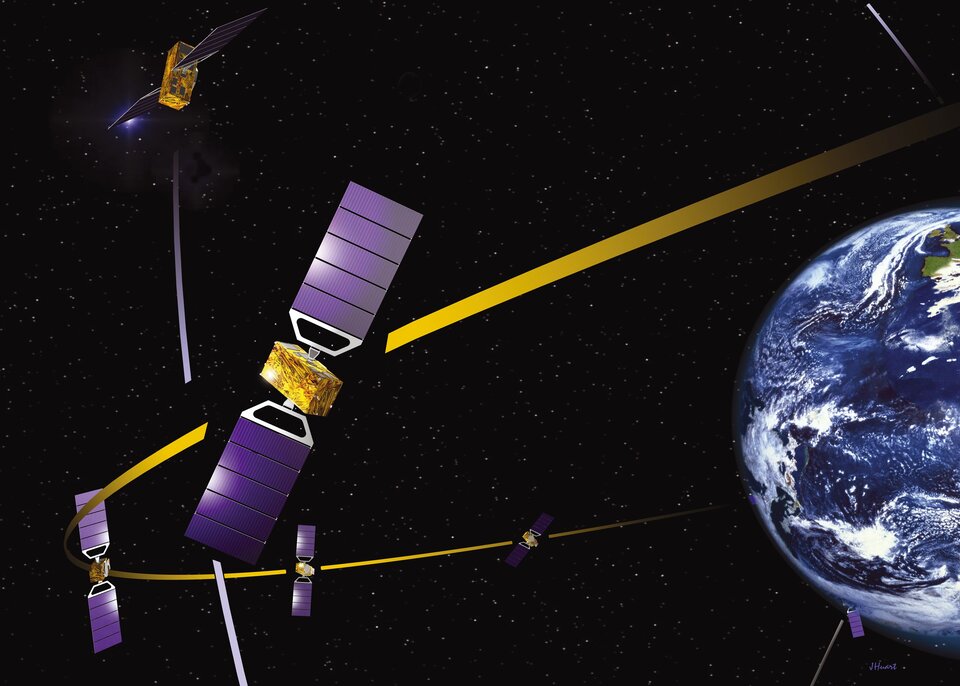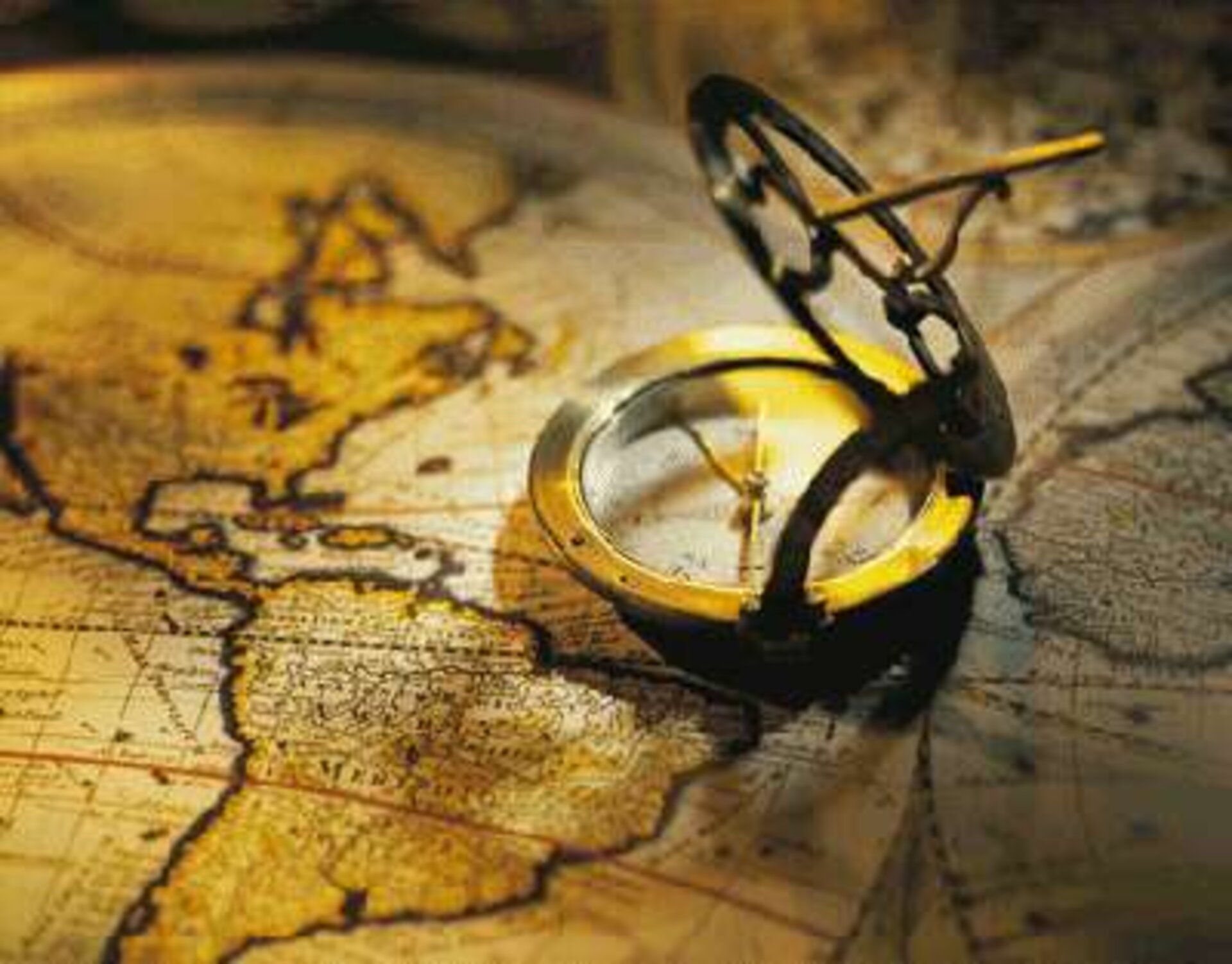About satellite navigation
Since the beginning of time, human beings have looked to the sky to determine their whereabouts. Traditionally, the Sun and the pattern of fixed stars have been their guides. But now, at the dawn of the second millennium, constellations of manmade satellites have taken over as beacons to guide the way.
What is satellite navigation?

Using the fixed stars, you can determine your position anywhere on the Earth’s surface to within a few hundred metres, provided the weather is fine. But navigation satellites can tell you where you are to the nearest 5 to 10 m, whatever the weather. Enhanced instruments can even pinpoint the position of a stationary object to within a few centimetres by measuring the object’s position many thousands of times over several hours and then working out the average of the measurements.
All you need to take advantage of this sophisticated new technology is a receiver to pick up signals transmitted by navigational satellites. The receiver technology is small enough to be incorporated into the electronics of a car, or even a mobile phone.
Indeed, manufacturers of such goods are already beginning to incorporate receivers into their products as standard. The day is approaching fast when we will be using satellite navigation routinely to avoid traffic jams in city centres, find the nearest free parking space, or even the nearest pizza restaurant in an unfamiliar city.
How does it work?
To pinpoint your location accurately, your receiver needs to receive signals from at least two navigational satellites. The receiver determines your distance from each of the satellites by measuring the time taken by the signal to travel from the satellite to your receiver antenna.
These distance measurements tell you that you are situated somewhere on the circle where two spheres intersect. The spheres have each of the two satellites at their centres and their radii are the satellite-receiver distances. If you are standing on the surface of the Earth, you are standing on the surface of a third sphere. Your position must be one of two points where the Earth’s surface touches the circle.
It is usually obvious which of the two points is the one you are occupying as the other is far away. In practice, a third satellite is needed to synchronise your receiver’s clock with a common standard time which is adhered to strictly by the clocks on board all the satellites (see next section).
If you want to determine your position in an aircraft above the surface of the Earth, however, you need to have a fourth satellite in view. In this case, the sphere which has the fourth satellite at its centre and a radius equal to the distance between that satellite and your receiver, takes the place of the Earth in the example above.
Three and four satellites are the minimum needed to determine positions on the surface of the Earth and above it. In general, the more satellites used the greater the positioning accuracy. Many receivers have channels for receiving signals from up to 15 satellites.
The importance of measuring time
Determining precise location depends on measuring accurately the distances between receiver and satellite, and that depends on very accurate measurement of signal travel time. As signals travel at the speed of light, travel times are tiny fractions of a second.
The receiver measures travel times by comparing ‘time marks’ imprinted on the satellite signals with the time recorded on the receiver’s clock. The time marks are controlled by a highly accurate atomic clock on board each satellite.
These clocks, however, are too expensive to incorporate into standard receivers, which have to make do with small quartz oscillators like those found in a wristwatch. Quartz oscillators are very accurate when measuring times of less than a few seconds, but inaccurate over longer periods. The solution is to re-set the receiver’s time to the satellite’s time continuously. This is done by the receiver processor using an approximation method involving signals from at least four satellites.
For this system of measurement to work, all satellites need to be synchronised so that they can start transmitting their signals at precisely the same time. This is achieved by continuously synchronising all on-board atomic clocks with a master clock on the ground. These super-accurate clocks can keep time to within one second in 100 million years!
Where are the navigational satellites?
It is only possible to determine a location on Earth if you know the location of the navigational satellites very precisely. This is achieved by placing the satellites in highly stable Medium Earth Orbits (MEOs) at an altitude of about 20 000 km. MEOs are the orbits of choice for a number of reasons: their stability enables exact orbit predictions; the satellites travel relatively slowly and so can be observed over several hours, like a fixed star; and, the satellites can be arranged in a constellation so that at least four are visible from any point on the Earth’s surface at any time.
Despite the predictability of the MEOs, it is still necessary for high positioning accuracy to monitor the precise location of each satellite constantly. This is done from a global network of reference stations on the ground, whose positions are known to within centimetres. Each satellite receives the reference stations’ data on its location, this is called ephemeris data, which it then relays with its signal to receivers.
What about errors?
Numerous errors can degrade the accuracy of a positioning. For example, errors in satellite to receiver distances can creep in if conditions within the ionosphere, the electrically charged outer layer of the atmosphere, slow down the signal. Conditions within the ionosphere are influenced by the level of activity on the surface of the Sun. Inaccurate distance measurements will also occur if the signal takes an unusually long path because it is reflected off many tall buildings or other surfaces before entering the receiver.
There are various ways of overcoming such inaccuracies. The best known is called differential satellite navigation, which uses a fixed receiver in a known position as a reference.
The time taken for the signal to travel from the satellite to the fixed receiver can be calculated precisely because the positions of the fixed receiver and the satellites (and hence the length of the travel path) are known precisely. Any difference between the calculated travel time and that actually measured reflects inaccuracies introduced by disturbances in the ionosphere.
If a moving receiver, attached to an aircraft for example, is within a few hundred kilometres of the fixed receiver, then it is fair to assume that the errors experienced by the signal in reaching both receivers will be roughly the same, as variations in ionospheric conditions tend to be similar over large areas. The timing errors determined by the fixed receiver can then be used to eliminate similar errors in the moving receiver. Major users of satellite navigation, such as large airports, may decide to use the differential technique by installing their own fixed receivers by the side of runways.
Another technique, which makes use of two positioning signals at two different frequencies, does away with the need for differential satellite navigation. It works on the principle that each frequency will be slowed down by a slightly different amount when travelling through the atmosphere. By sending the two frequencies at the same time and recording the time difference between their arrivals, it is possible to build up a model of ionospheric conditions. This dual-frequency technique can increase positioning accuracy to within 1 to 2 m. This will be standard with Galileo, Europe’s planned satellite navigation system, but at present it is available only for military use with the US GPS and Russian GLONASS systems.
Finally, it is possible to determine positions to within a few tens of centimetres using a technique called TCAR (Three Carrier Ambiguity Resolution). TCAR eliminates inaccuracies by looking at the wavelike structure of the signal and determining how much it has been pushed along during its passage through the atmosphere. Such phase shifts can be measured to within a fraction of the wavelength, which is typically 20 cm.
The calculations needed to do TCAR are presently beyond the capabilities of the standard hand-held receiver and this technique is used mainly for long-term monitoring of movement in buildings, oil pipelines, changes in sea level and even changes in the shape of the Earth’s crust.
How many satellite navigation systems are there

The US and Russia provide the two global satellite navigation systems now available. A third system, Galileo, to be built and operated in Europe, is due to come on line between 2005-2008. The three systems will be fully interoperable, which means that a user on Earth will be able to determine a position with any receiver picking up signals from any combination of satellites belonging to any of the three systems.
A satellite navigation system consists of a space segment, typically 24 navigational satellites, a ground or control segment and a user segment. The satellites are placed in circular orbits at heights of about 20 000 km so that at least four are visible from any point on the Earth’s surface at any time.
The ground or control segment consists of several tracking stations placed at different locations over the Earth’s surface, and a central ground station. The tracking stations monitor the position and health of the satellites, send data back to the central station for processing and then relay accurate measurements of each satellite’s position to the satellite for incorporation into its navigational signal.
The user segment consists of the users of the GPS system who are equipped with terminals to receive the satellites’ navigational signals.
The first navigational satellite was launched in 1978 and was the forerunner of the US GPS system, which was originally developed for the US Department of Defense. The GPS system is now operated from the Shriever Air Force Base in Colorado. The first satellite in the Russian GLONASS system was launched in 1982. GLONASS is operated from a system control centre near Moscow. Europe’s approach to the Global Navigation Satellite System is based on EGNOS (European Geostationary Overlay Service) complementing and improving GPS, from 2005 and paving the way for Galileo which will be the first complete civil system. The first Galileo satellite will be launched at the end of 2005. Galileo is being developed by the European Space Agency and the European Commission.




